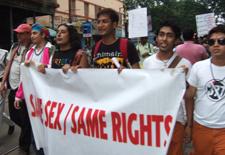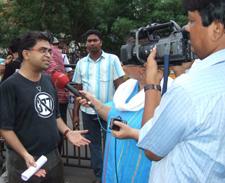
REPEAL 377. SAATHII activists march in Kolkata's Pride parade. Credit: courtesy of Pawan Dhall
At only 40 years of age, Pawan Dhall is already known as a godfather of India’s gay rights movement.
In the ’80s, he came out to his parents while he was still in high school. In 1999, he marched in Kolkata’s first Gay Pride parade, along with only 15 others. And now, he heads up East India’s branch of SAATHII (Solidarity and Action Against the HIV Infection in India).
I was truly honoured that he invited me to share a chai with him in his Kolkata office. Greying at the temples and speaking with an endearing lisp, he explains that India’s main gay rights goal is to abolish Section 377, which criminalizes homosexuality. Activists first raised the idea with politicians in 1994, he says, but their cause was ridiculed. So, since 2001, they’ve been taking their case to the courts.
Dhall says that gay rights groups, led by India’s Naz Foundation, finally feel like they’re making progress. They recently cleared a major hurdle — convincing children’s rights groups to drop the language in Section 377 that compares homos to paedophiles.
According to Dhall, decriminalizing homosexuality would make his HIV/AIDS job a lot easier. Currently, it’s hard for the organization just to distribute condoms — especially in prison. And NGOs like SAATHII face the burden of tracking the country’s many gay bashings, since police don’t acknowledge the problem. If Section 377 were abolished, Dhall could also stop locking the doors at SAATHII’s office.
“Our library is so full of stuff that, technically, I should be meeting you in prison,” he says.
The rate of HIV/AIDS among men who have sex with men in India is higher than any other population in the country. Dhall says it’s estimated that 7.4 percent of the country’s gays are infected, compared to less than 1 percent of the population as a whole. As of 2008, 2.4 million Indians have HIV/AIDS, the third highest number in the world after South Africa and Nigeria.
India’s laws prevent groups like SAATHII from targeting men who have sex with men directly in their campaigns. “In the public psyche,” Dhall says, “male to male is just fun, not sex.” Many guys still don’t know how to use condoms.
Dhall is encouraged, though, by the steady rise in the number of people willing to march in India’s Pride parades. This year, almost 500 took part in Kolkata, he says, and contrary to reports in the Western media (which I regretfully repeated in my first column), “Just a handful of people wore masks. Everyone else was out and about.”
Surprisingly, says Dhall, parade-goers were left alone, even during the post-march speeches. “We spoke to our heart’s content,” he says. “Police are supportive of the walk, but not the rest of the year.”
Dhall himself is currently single, though he’s had boyfriends in the past. Like most Indian men — even those who are married — he still lives in the same house he’s always shared with his parents. When he came out, he says, “I got enough support in the sense I wasn’t thrown out.”
But when it comes to picking a bride, as all Indian men are expected to do, he adds, “People in my extended family only stopped harassing me five years ago.”
Dhall is confident that Section 377 won’t exist much longer. India’s last two health ministers have actually come out against it. But once homosexuality is decriminalized, he’s reluctant to fight for same-sex marriage.
“There is no guarantee that marriage means happiness,” he says, especially in a country that still forces most of its couples together in arranged unions. “I would encourage everyone to question marriage and focus on relationships.”
Before I leave, Dhall tells me about a groundbreaking gay movie from India called My Brother Nikhil. It turns out that Bollywood is starting to discover gays in a big way. But that will have to wait for next week’s column.

 Why you can trust Xtra
Why you can trust Xtra